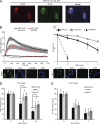PARP1 promotes nucleotide excision repair through DDB2 stabilization and recruitment of ALC1
- PMID: 23045548
- PMCID: PMC3471223
- DOI: 10.1083/jcb.201112132
PARP1 promotes nucleotide excision repair through DDB2 stabilization and recruitment of ALC1
Abstract
The WD40-repeat protein DDB2 is essential for efficient recognition and subsequent removal of ultraviolet (UV)-induced DNA lesions by nucleotide excision repair (NER). However, how DDB2 promotes NER in chromatin is poorly understood. Here, we identify poly(ADP-ribose) polymerase 1 (PARP1) as a novel DDB2-associated factor. We demonstrate that DDB2 facilitated poly(ADP-ribosyl)ation of UV-damaged chromatin through the activity of PARP1, resulting in the recruitment of the chromatin-remodeling enzyme ALC1. Depletion of ALC1 rendered cells sensitive to UV and impaired repair of UV-induced DNA lesions. Additionally, DDB2 itself was targeted by poly(ADP-ribosyl)ation, resulting in increased protein stability and a prolonged chromatin retention time. Our in vitro and in vivo data support a model in which poly(ADP-ribosyl)ation of DDB2 suppresses DDB2 ubiquitylation and outline a molecular mechanism for PARP1-mediated regulation of NER through DDB2 stabilization and recruitment of the chromatin remodeler ALC1.
Figures








References
-
- Cleaver J.E., Bodell W.J., Morgan W.F., Zelle B. 1983. Differences in the regulation by poly(ADP-ribose) of repair of DNA damage from alkylating agents and ultraviolet light according to cell type. J. Biol. Chem. 258:9059–9068 - PubMed
Publication types
MeSH terms
Substances
LinkOut - more resources
Full Text Sources
Molecular Biology Databases
Miscellaneous

